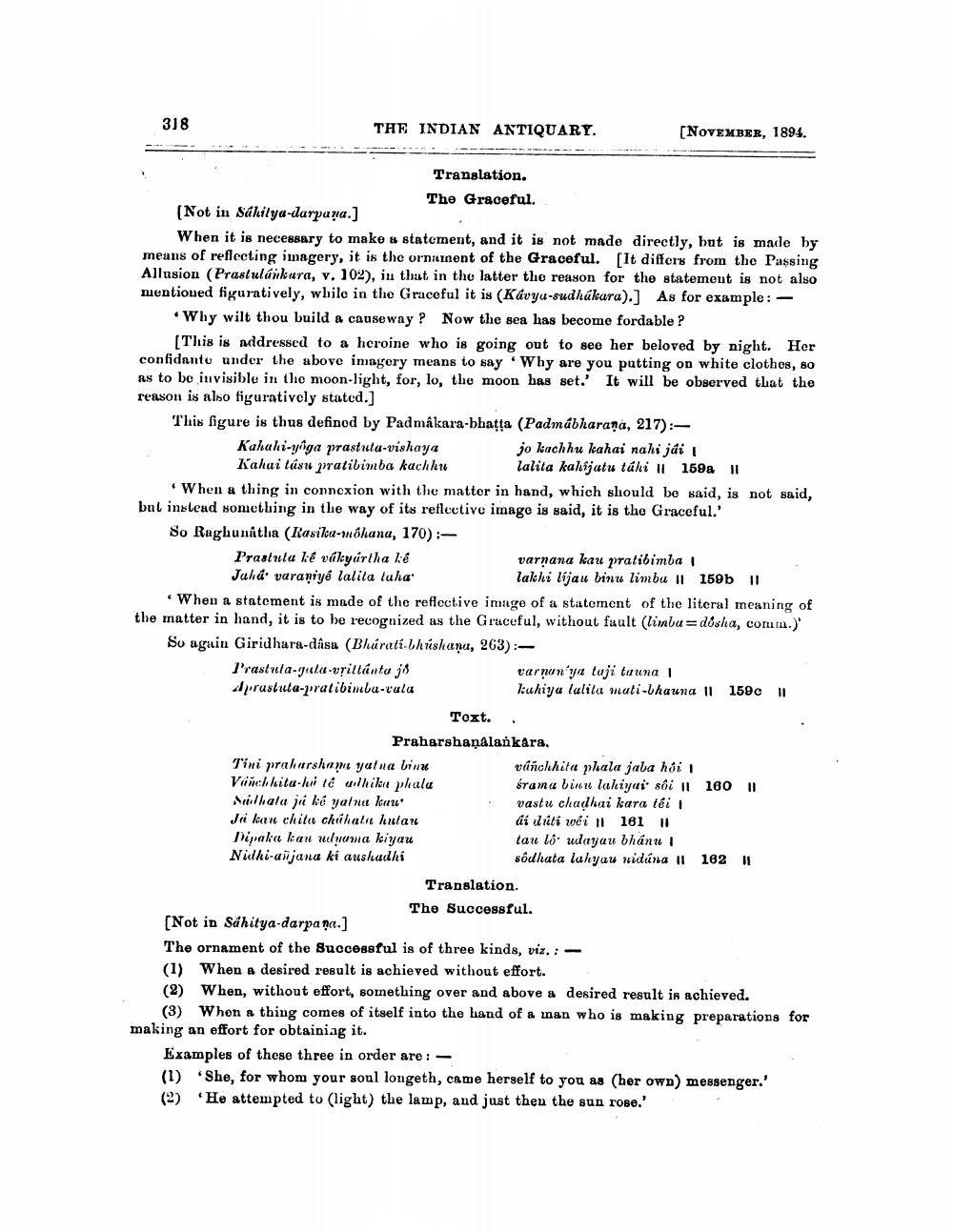________________
318
THE INDIAN ANTIQUARY.
[NOVEMBER, 1894.
Translation.
The Graceful. (Not in Sahilya-darpana.]
When it is necessary to make a statement, and it is not made directly, but is made by means of reflecting imagery, it is the ornament of the Graceful. [It differs from the Passing Allusion (Praslulánkura, v. 102), in thut in the latter the reason for the statement is not also mentioned figuratively, while in the Graceful it is (Kavyu-sudhákara).] As for example: -
Why wilt thou build a causeway? Now the sea has become fordable ?
[This is addressed to a heroine who is going out to see her beloved by night. Her confidantu under the above imagery means to say Why are you putting on white clothes, so as to be invisible in the moon-light, for, lo, the moon has set. It will be observed that the reason is also figuratively stated.] This figure is thus definod by Padmakara-bhatta (Padmábharana, 217) :Kahahi-ynga prastuta-vishaya
jo kachhu kahai nahi jái Kahai lásu pratilimba kachhere lalita kahijatu táhi ll 1598 • When a thing in connexion with the matter in hand, which should be said, is not said, but instead something in the way of its reflective image is said, it is the Graceful.' So Raghunatha (Rasiku-mohana, 170) :Prastula ke vákyúrtha le
varnana kau pratibimba Jahá' varaniyé lalita tuha'
lakhi lijau binu limbu | 1505 II When a statement is made of the reflective image of a statement of the literal meaning of the matter in hand, it is to be recognized as the Graceful, without fuult (limbu=dôsha, comum.' So uguin Giridhara-dâsu (Bhúratí-lhushanu, 263):-- l'rastula-juta-vritlánta jo
varnon'ya taji tuuna Aprastuta-puratibimba-rata
kahiya lalila mati-Chauna 11 1590 11 Toxt..
Praharshaņalankara. Tini praharshane yatua linae
tấme hita plala jaba hối 1 Viinchhitu-li te wilhikit phala
śrama binu lahiyai sôi il 160 11 Milhala ji ke yalna kuu
vastu chadhai kara téi! Ji kan chita chihali hular
di uti wéi 11 161 11 Dipaka kan ulama kiyau
ta lô" dat ao bhân | Nidhi-aijana ki aushadhi
sódhata lahyau ridána il 162 Translation.
The Successful. [Not in Sahitya-darpaņa.] The ornament of the Successful is of three kinds, viz. :(1) When a desired result is achieved without effort. (2) When, without effort, something over and above a desired result is achieved.
(3) Whon a thing comes of itself into the hand of a man who is making preparations for making an effort for obtainiag it.
Examples of these three in order are: - (1) She, for whom your soul longeth, came herself to you as (her own) messenger.' (2) He attempted to (light) the lamp, and just then the sun rose.'




